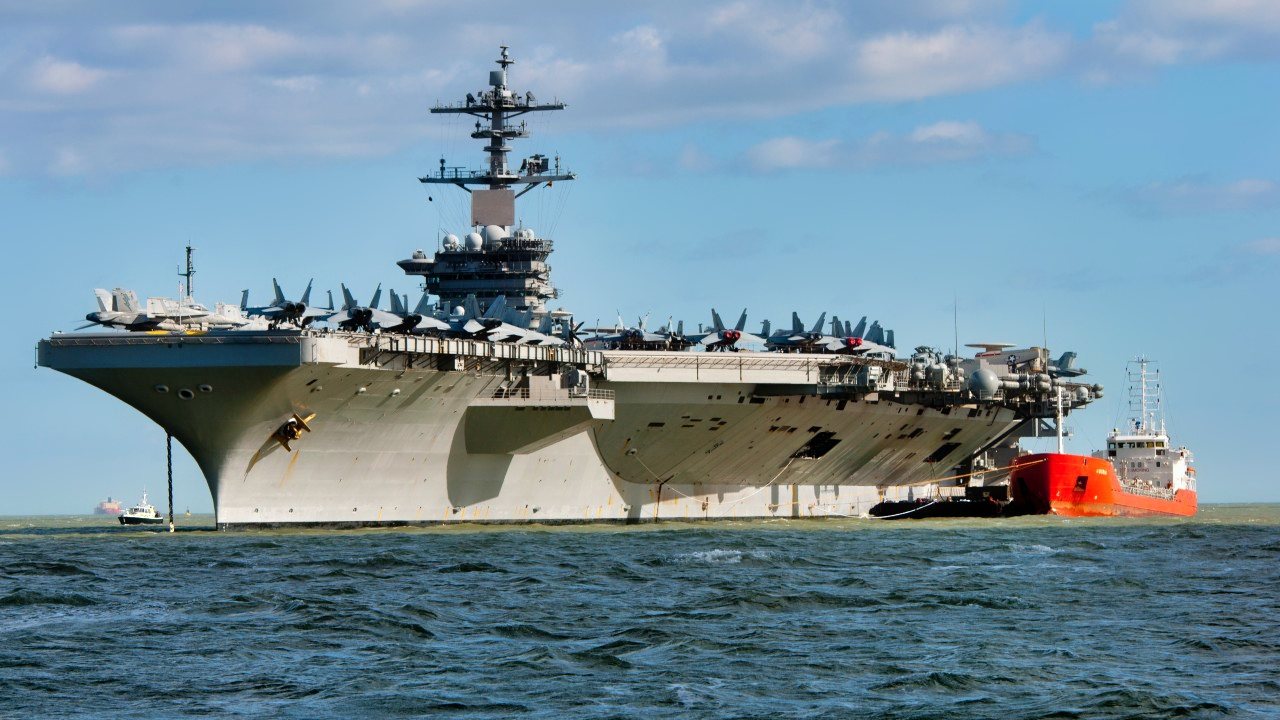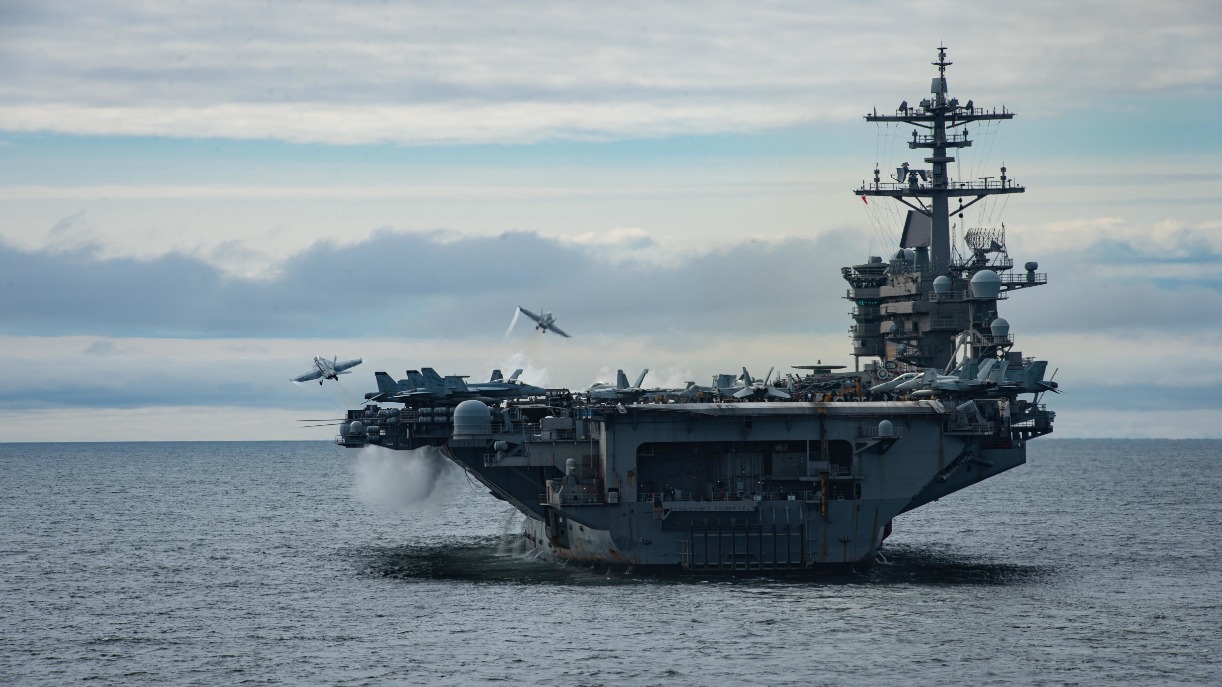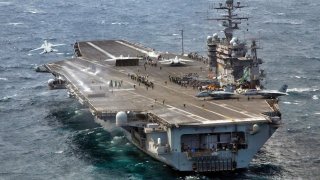The Houthis Freaked: Aircraft Carrier USS Theodore Roosevelt Is Sailing In Their Backyard
The USS Theodore Roosevelt (CVN-71), a Nimitz-class nuclear-powered supercarrier, has arrived in the Red Sea to project power and deter aggression.
Summary and Key Points: The USS Theodore Roosevelt (CVN-71), a Nimitz-class nuclear-powered supercarrier, has arrived in the Red Sea to project power and deter aggression.

-This deployment marks the first time since 2021 that a U.S. Navy Indo-Pacific-based aircraft carrier has been sent to the region.
-Known as "The Big Stick," CVN-71 has a storied history of service, including significant roles in Operation Desert Storm and Operation Enduring Freedom.
The Big Stick in Action: USS Theodore Roosevelt's New Mission
It was the late President Theodore Roosevelt's policy that called for the U.S. to walk softly and "carry a big stick," so it is fitting that the Nimitz-class nuclear-powered supercarrier named for him has now arrived in the Red Sea to project power and serve as a deterrent to America's adversaries.
"The Theodore Roosevelt Carrier Strike Group (TRCSG) arrived in the U.S. 5th Fleet area of operations July 12 to deter aggression, promote regional stability, and protect the free flow of commerce in the region," the United States Central Command (CENTCOM) said in a statement on X – the social media platform formerly known as Twitter – on Friday.
The carrier, USS Theodore Roosevelt (CVN-71), which is also fittingly nicknamed "The Big Stick," replaced her sister Nimitz-class flattop USS Dwight D. Eisenhower (CVN-69), which arrived home this past weekend. CVN-71's deployment to the Middle East marks the first time a U.S. Navy Indo-Pacific-based aircraft carrier has been sent to the region since 2021 when the U.S. evacuated the last of its troops from Afghanistan – however, it has left a "gap" in the Pacific.
It is unclear if the Houthi rebels in Yemen, which have targeted commercial shipping in the Red Sea and the Gulf of Aden purportedly in support of Hamas, recognize that the two carriers were named for U.S. Army generals turned presidents – and were both men who guided their soldiers to victory and then the nation.
A Tough Aircraft Carrier Named for a Tough Man
Though no battleship was ever named for the president and war hero four vessels have been named in his honor, including the fourth Nimitz-class supercarrier. It is truly a special ship. USS Theodore Roosevelt (CVN-71) was the first aircraft carrier to be assembled in large sections, or modules. Much like building a model, the innovative construction techniques employed with Theodore Roosevelt have been used on every aircraft carrier since.
This sped her construction and she was launched in October 1984 and commissioned two years later in October 1986. The carrier began her maiden deployment in late December 1988 with Carrier Air Wing Eight (CVW-8) embarked.
However, it almost never happened. President Gerald Ford had canceled the order for CVN-71 in 1976. Instead, Ford sought to build two conventional-powered carriers that could operate with vertical and/or short takeoff and landing aircraft. President Jimmy Carter also initially opposed the building of the nuclear-powered carrier, but he reversed course following the Iran hostage crisis, which highlighted the need for U.S. carrier battle groups to remote regions of the world. Construction of CVN-71 was finally authorized under the Fiscal Year 1980 (FY80) authorization bill for the Department of Defense (DoD).
USS Theodore Roosevelt Goes to War
While named for the man who remarked it was wise to speak softly and carry a big stick, Roosevelt was still one who didn't shy away from doing his part. So it was somewhat fitting that just over two years after entering service, USS Theodore Roosevelt was deployed to take part in Operation Desert Shield and arrived in the Persian Gulf in mid-January 1991.
During the subsequent Operation Desert Storm, which began just the day before the carrier arrived on station, the vessel took part in combat operations where pilots flew more than 4,200 sorties – more than any other carrier during the brief conflict. In total, aircraft operating from Theodore Roosevelt dropped more than 4.8 million pounds of ordnance!
The warship's airwing later took part in patrols during Operation Provide Comfort to support Kurdish forces in Iraq, and then a year later in Operation Deny Flight to support the U.S. no-fly zone over Bosnia. CVN-71 became one of only a few nuclear-powered warships to transit the Suez Canal when she was deployed to participate in Operation Southern Watch over Iraq.
USS Theodore Roosevelt began her seventh deployment just after the September 11, 2001, terrorist attacks on New York City and the Pentagon, and joined the already-present USS Enterprise (CVN-65) and USS Carl Vinson (CVN-70). She later conducted attacks against al-Qaeda forces in Afghanistan during Operation Enduring Freedom. While deployed in the region, Theodore Roosevelt spent a total of 160 consecutive days at sea, and broke the record for the longest period underway of a U.S. carrier since World War II.
The carrier is also one of the most decorated warships of the post-Cold War era. Her awards include a Joint Meritorious Unit Award, three Navy Unit Commendations, five Battle Efficiency Awards (Battle "E"), two National Defense Service Medals, two Security Excellence Awards, and a Global War on Terrorism Expeditionary Medal among others. The warship also was awarded a NATO Medal as well as Kuwait Liberation Medals from both Kuwait and Saudi Arabia.

According to the Navy Times, CVN-71's crew also received the Combat Action Ribbon (CAR), for past service in the Middle East. That award, which is reserved for U.S. Navy sailors and United States Marines "who actively participated in ground or surface action," has rarely been given to sailors since the 1991 Gulf War.
It was in March 2022 that CVN-71 received the 2021 Battle Efficiency Award, and the Battle "E" award highlights the crew's high level of sustained proficiency and readiness to perform in an operational environment throughout a year-long evaluation.
The Houthis haven't realized what they are facing.
Author Experience and Expertise: Peter Suciu
Peter Suciu is a Michigan-based writer. He has contributed to more than four dozen magazines, newspapers, and websites with over 3,200 published pieces over a twenty-year career in journalism. He regularly writes about military hardware, firearms history, cybersecurity, politics, and international affairs. Peter is also a Contributing Writer for Forbes and Clearance Jobs. You can follow him on Twitter: @PeterSuciu. You can email the author: [email protected].
All images are Creative Commons.


